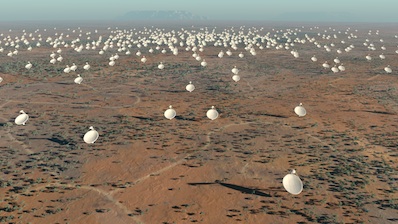
Square Kilometre Array: site selection due imminently
DR EMILY BALDWIN
ASTRONOMY NOW
Posted: 27 March 2012


The next generation of radio telescope, the Square Kilometre Array (SKA), will be hosted by either South Africa or Australia and New Zealand, a decision that is due in around two weeks time.
“We are undergoing a revolution in radio astronomy,” said keynote speaker Michael Kramer from the Max Planck Institute for Radio Astronomy and the University of Manchester’s Jodrell Bank during the National Astronomy Meeting 2012’s opening lecture this morning. “We are on the verge of confirming some of the most revolutionary theories of the last century and we need big machines to do that!”

Around 3,000 dishes will make up the Square Kilometre Array. Image: SPDO/Swinburne Astronomy Productions.
The SKA will be able to answer wide-ranging questions covering the Universe’s early structure, dark matter, galaxy formation, pulsars, gravitational waves, cosmic magnetism, black holes and the detection of organic molecules in protoplanetary discs – possibly even life beyond Earth.
The array, as its name suggests, will create a telescope with a collecting area equivalent to a dish of one square kilometre. Comprising around 3,000 dishes reaching 3,000 kilometres from a central core, three antenna types will provide continuous frequency coverage from 70 MHz to 10 GHz, in order to meet the science demands of the project.
SKA will use technology already demonstrated by pathfinder projects such as LOFAR, the Low Frequency Array, which is spread across the Netherlands and northern Europe, but the enormity of SKA requires many new technology considerations. Kramer reports that the SKA will produce on the order of one exabyte of data per day, enough raw data to fill 15 million 64 GB iPods, and more than all the information collected by humankind so far.
The location of the 1.5 billion euro project will be announced by the SKA Site Selection Group in the next two weeks, and will take into account physical characteristics of the site, power supply and distribution, and the long term sustainability of the sites as radio quiet zones.
Stay tuned to astronomynow.com for future updates.
|



